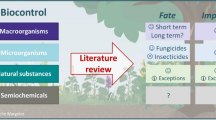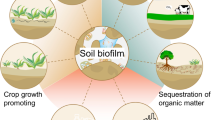Abstract
γ-Hexachlorocyclohexane (γ-HCH) persists in the environment and is recalcitrant to microbial degradation. To determine the extent of the microbial potential for the degradation of γ-HCH the diversity of bacteria from 12 soil samples collected around insecticide- and pesticide-producing factories in Egypt were assessed and compared with biofilm communities grown on γ-HCH microcrystals. From all samples, highly diverse microbes were isolated, able to grow on γ-HCH as sole source of carbon. The same soil samples were used to inoculate γ-HCH microcrystals on a substratum in microcosms to grow biofilm communities. All soil samples formed multispecies biofilms on γ-HCH. Biofilms stained with Nile Red showed distinct cell clusters of high hydrophobicity, and it is speculated that these aggregates have a substantial role in the degradation of the hydrophobic substrate. While many Bacillus species were isolated, this group was almost absent in the different biofilm communities. The finding of cells with highly hydrophobic envelopes together with the differences in species composition between isolates and interacting microbial communities points to fundamental differences in the interaction with hydrophobic substrates of single strains and microbial communities.





Similar content being viewed by others
References
Abraham, W.-R., Strömpl, C., Meyer, H., Lindholst, S., Moore, E. R. B., Bennasar, A., Christ, R., Vancanneyt, M., Tindall, B., Smit, J., & Tesar, M. (1999). Phylogeny and polyphasic taxonomy of Caulobacter species. Proposal of Maricaulis gen. nov. with M. maris (Poindexter) comb. nov. as type species and emended description of Caulobacter and Brevundimonas. International Journal of Systematic Microbiology, 49, 1053–1073.
Alvarez, A., Benimeli, C. S., Saez, J. M., Fuentes, M. S., Cuozzo, S. A., Polti, M. A., & Amoroso, M. J. (2012). Bacterial bio-resources for remediation of hexachlorocyclohexane. International Journal of Molecular Sciences, 13, 15086–15106.
Andrews, J. S., Rolfe, S. A., Huang, W. E., Scholes, J. D., & Banwart, S. A. (2010). Biofilm formation in environmental bacteria is influenced by different macromolecules depending on genus and species. Environmental Microbiology, 12, 2496–2507.
Bachmann, A., Walet, P., Wijnen, P., De Bruin, W., Huntjens, J. L., Roelofsen, W., & Zehnder, A. J. (1988). Biodegradation of alpha- and beta-hexachlorocyclohexane in a soil slurry under different redox conditions. Applied and Environmental Microbiology, 54, 143–149.
Bassam, B. J., & Gresshoff, P. M. (2007). Silver staining DNA in polyacrylamide gels. Nature Protocols, 2, 2649–2654.
Benimeli, C. S., Castro, G. R., Chaile, A. P., & Amoroso, M. J. (2006). Lindane removal induction by Streptomyces sp. M7. Journal of Basic Microbiology, 46, 348–357.
Boltner, D., Moreno-Morillas, S., & Ramos, J. L. (2005). 16S rDNA phylogeny and distribution of lin genes in novel hexachlorocyclohexane-degrading Sphingomonas strains. Environmental Microbiology, 7, 1329–1338.
Edwards, S. J., & Kjellerup, B. V. (2013). Applications of biofilms in bioremediation and biotransformation of persistent organic pollutants, pharmaceuticals/personal care products, and heavy metals. Applied Microbiology and Biotechnology, 97, 9909–9921.
Elcey, C. D., & Kunhi, A. A. (2010). Substantially enhanced degradation of hexachlorocyclohexane isomers by a microbial consortium on acclimation. Journal of Agricultural and Food Chemistry, 58, 1046–1054.
Euzéby, J. P. (2014). List of prokaryotic names with standing in nomenclature. www.bacterio.net. Accessed 4 March 2016.
Hall-Stoodley, L., Costerton, J. W., & Stoodley, P. (2004). Bacterial biofilms: from the natural environment to infectious diseases. Nature Reviews Microbiology, 2, 95–108.
Harry, M., Gambier, B., & Garnier-Sillam, E. (2000). Soil conservation for DNA preservation for bacterial molecular studies. European Journal of Soil Biology, 36, 51–55.
Lal, R., Dogra, C., Malhotra, S., Sharma, P., & Pal, R. (2006). Diversity, distribution and divergence of lin genes in hexachlorocyclohexane-degrading sphingomonads. Trends in Biotechnology, 24, 121–130.
Macedo, A. J., & Abraham, W.-R. (2009). Microcosms for biofilm analysis on hydrophobic substrates – A multiple approach to study biodiversity, metabolic activity and biofilm structure and dynamic. In K. N. Timmis (Ed.), Handbook of hydrocarbon microbiology: microbial interactions with hydrocarbons, oils, fats and related hydrophobic substrates and products (pp. 3544–3551). New York: Springer.
Macedo, A. J., Kuhlicke, U., Neu, T. R., Timmis, K. N., & Abraham, W.-R. (2005). Three stages of a biofilm community developing at the liquid-liquid interface between polychlorinated biphenyls and water. Applied and Environmental Microbiology, 71, 7301–7309.
Macedo, A. J., Timmis, K. N., & Abraham, W.-R. (2007). Widespread capacity to metabolize polychlorinated biphenyls by diverse microbial communities in soils with no significant exposure to PCB contamination. Environmental Microbiology, 9, 1890–1897.
Matz, C., Bergfeld, T., Rice, S. A., & Kjelleberg, S. (2004). Microcolonies, quorum sensing and cytotoxicity determine the survival of Pseudomonas aeruginosa biofilms exposed to protozoan grazing. Environmental Microbiology, 6, 218–226.
Mohn, W. W., Mertens, B., Neufeld, J. D., Verstraete, W., & De Lorenzo, V. (2006). Distribution and phylogeny of hexachlorocyclohexane-degrading bacteria in soils from Spain. Environmental Microbiology, 8, 60–68.
Mosmann, T. (1983). Rapid colorimetric assay for cellular growth and survival: application to proliferation and cytotoxicity assays. Journal of Immunological Methods, 65, 55–63.
Nalin, R., Simonet, P., Vogel, T. M., & Normand, P. (1999). Rhodanobacter lindaniclasticus gen. nov., sp. nov., a lindane-degrading bacterium. International Journal of Systematic Bacteriology, 49, 19–23.
Nayyar, N., Sangwan, N., Kohli, P., Verma, V., Kumar, R., Negi, V., Oldach, P., Mahato, N. K., Gupta, V., & Lal, R. (2014). Hexachlorocyclohexane: persistence, toxicity and decontamination. Reviews on Environmental Health, 29, 49–52.
Nielsen, A. T., Tolker-Nielsen, T., Barken, K. B., & Molin, S. (2000). Role of commensal relationships on the spatial structure of a surface-attached microbial consortium. Environmental Microbiology, 2, 59–68.
Pelz, O., Tesar, M., Wittich, R. M., Moore, E. R. B., Timmis, K. N., & Abraham, W.-R. (1999). Towards elucidation of microbial community metabolic pathways: unravelling the network of carbon sharing in a pollutant-degrading bacterial consortium by immunocapture and isotopic ratio mass spectrometry. Environmental Microbiology, 1, 167–174.
Phillips, T. M., Seech, A. G., Lee, H., & Trevors, J. T. (2005). Biodegradation of hexachlorocyclohexane (HCH) by microorganisms. Biodegradation, 16, 363–392.
Sahu, S. K., Patnaik, K. K., Sharmila, M., & Sethunathan, N. (1990). Degradation of alpha-, beta-, and gamma-hexachlorocyclohexane by a soil bacterium under aerobic conditions. Applied and Environmental Microbiology, 56, 3620–3622.
Sambrook, J., & Russell, D. W. (2001). Molecular cloning. A laboratory manual (3rd ed.). New York: Cold Spring Harbor Laboratory Press.
Schachter, B. (2003). Slimy business—the biotechnology of biofilms. Nature Biotechnology, 21, 361–365.
Schmalenberger, A., Schwieger, F., & Tebbe, C. C. (2001). Effect of primers hybridizing to different evolutionarily conserved regions of the small-subunit rRNA gene in PCR-based microbial community analyses and genetic profiling. Applied and Environmental Microbiology, 67, 3557–3563.
Schwieger, F., & Tebbe, C. C. (1998). A new approach to utilize PCR-single-strand-conformation polymorphism for 16S rRNA gene-based microbial community analysis. Applied and Environmental Microbiology, 64, 4870–4876.
Sievers, F., Wilm, A., Dineen, D., Gibson, T. J., Karplus, K., Li, W., Lopez, R., McWilliam, H., Remmert, M., Söding, J., Thompson, J. D., & Higgins, D. G. (2011). Fast, scalable generation of high-quality protein multiple sequence alignments using Clustal Omega. Molecular Systems Biology, 7, 539.
Singh, B. K., Kuhad, R. C., Singh, A., Tripathi, K. K., & Ghosh, P. K. (2000). Microbial degradation of the pesticide lindane (gamma-hexachlorocyclohexane). Advances in Applied Microbiology, 47, 269–298.
Tamura, K., Stecher, G., Peterson, D., Filipski, A., & Kumar, S. (2013). MEGA6: Molecular Evolutionary Genetics Analysis version 6.0. Molecular Biology and Evolution, 30, 2725–2729.
Tillmann, S., Strömpl, C., Timmis, K. N., & Abraham, W.-R. (2005). Stable isotope probing reveals the dominant role of Burkholderia sp. in aerobic degradation of PCBs. FEMS Microbiology Ecology, 52, 207–217.
Acknowledgements
We are indebted to Jennifer Skerra and Esther Surges for all their help in the laboratory and to Dr. Maximiliano G. Gutierrez for his efforts in the microscopic studies. A.S.G. acknowledges a Ph.D. stipend from the Egyptian mission government.
Author information
Authors and Affiliations
Corresponding author
Ethics declarations
Conflict of Interest
The authors declare that they have no conflict of interest.
Rights and permissions
About this article
Cite this article
Gebreil, A.S., Abraham, WR. Diversity and Activity of Bacterial Biofilm Communities Growing on Hexachlorocyclohexane. Water Air Soil Pollut 227, 295 (2016). https://doi.org/10.1007/s11270-016-2988-7
Received:
Accepted:
Published:
DOI: https://doi.org/10.1007/s11270-016-2988-7




